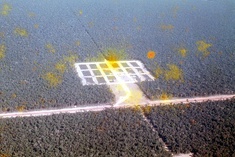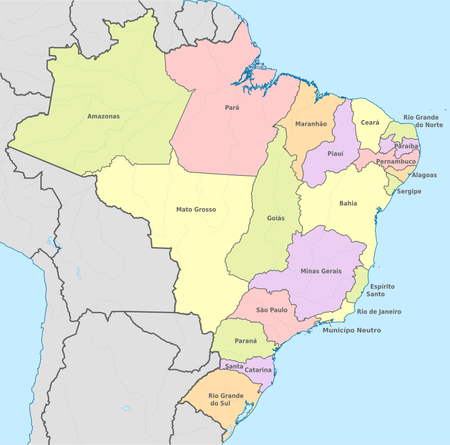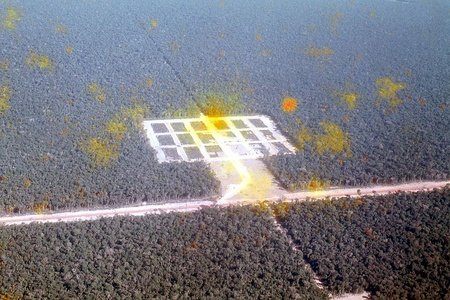
Toponyms of Brazilian Cities #4
First published: Wednesday February 23rd, 2022
Report this blog
Can you buy me a city, please?
Here we go for the fourth post of this series about Brazilian toponymy. The first three posts focused on municipalities named after Catholic religion, indigenous languages and historical figures, covering probably the majority of Brazilian municípios' names - as I said before, most of the Brazilian municipalities are named after a Saint (or a member of the Holy Family) or a historical figure (like a president or governor) or an indigenous name for a region or river. It seems pointless to do a post, for example, only about municípios named after a river!, since most of the rivers names are indigenous. So, as there are few toponymy left, this one may be (or may not, who knows?) the last post on this series.
Anyway, there are cities named after economic activities, and they can be interesting when you think of them historically. As you may (or may not) know, Brazil was a Portuguese colony from 1500 to 1815 [1], and during this three centuries our economy was based mainly on agriculture and mining. Our country had many production cycles (sugarcane during 16th and 17th centuries, gold during 17th and 18th centuries, cotton and coffee during the 19th century, rubber during the first decades of 20th century) that lived side-by-side with lesser profitable activities (such as cattle breeding, fishery and subsistence agriculture).
Some municípios' names still show the importance one of these cycles had to their development. In this post, I will start talking about these cities. Then, on the second half, I will talk about a interesting specificity of Brazilian toponymy: cities named after business/enterprises.
Cities named after economic activities
Minas Gerais has the greatest examples of cities named after economic activities. Matter of fact, the state itself is named after economy: it means general mines, in reference to the gold and diamond mines that supplied Portugal with minerals. At Minas Gerais, you will find (an probably visit the first two, if you come to Brazil for tourism) the cities of Ouro Preto ("Black Gold", referring to the gold extracted in the city, which was covered with iron oxide), Diamantina (referring to "Diamond"), Itabira and Itabirito (both refer to the itabirito - "stone that leaves a red line" in tupi -, a type of hematite composed by 66% iron and found in this region) and Conceição dos Ouros ("Immaculate Conception of the Gold", referring both to Virgin Mary and to the gold found on the river that crosses the city). At Minas Gerais also lies the cities of Cana Verde ("green cane") and Canápolis ("city of the cane"), both referring to the sugarcane plantations.

I can think of few examples outside of Minas Gerais, to be honest. Two of them are funny names: Açailândia ("land of the açaí palm", whose leaves were used to build the first houses) and Pescaria Brava (it can be translated as "brave fishery" or "angry fishery", depending on which theory of the name you believe: the first one says the men from the village were brave to fight the sea during the fishing, and the second one says its population would get very angry when trying to divide the caught fishes). There is also Vinhedo ("vineyard", because grape was/is the main production of the city), Batatais (it can be either "potato plantation" or mbai-ta-ta, the fire snake from Tupian mithology who prevented wildfires), Cafelândia ("land of coffee") and Ramilândia ("land of the ramie").
Cities named after business
Even more interesting than cities named after economic activities, in Brazil we have some cities named after business. Most of them were established during the 20th century, when we had our own westward expansions (called Marcha para o Oeste, "march to the West") to occupy the Central-West region. When Getúlio Vargas took over the control of the country after the 1930 Revolution, his goal was to "modernize" the country and integrate all our territory. For the past four centuries, this region was called sertão (a very specific name for the Brazilian countrysides, translated as "hinterland") and was inhabited mainly by indigenous, small farmers and gold miners. Vargas goal was to integrate this area to the coastal economy and try solving land-owning issues/conflicts (long story short, Brazilian history is basically dictated by rich landowners grabbing poorer farmers land and enslaving them - or continuing enslaving black people after slavery was abolished in 1888). Rural areas in Mato Grosso, Goiás and Paraná were sold to the gaúchos, generic name for farmers of Southern Brazil (and also the demonym to those born in Rio Grande do Sul), who would come to these sertões and start agricultural productions. Usually, the lands were sold to real estate companies, which would rent small areas to the producers and establish a city to attract businessmen.
The Marcha started (if you do not know the Brazilian map by heart, look at the next image) on western Paraná and southern Mato Grosso in the decades of 1930 and 1940. In 1960, the new capital, Brasília, was founded on the heart of the country to attract more and more . During the military dictatorship (1964-1985), the march spread through northern Mato Grosso and reached the Amazon forest, with the motto "integrate to not lose" the inhospitable territories - I talked about that a little on the #3 post of the series. This expansion was important for the development of the present states of Mato Grosso, Rondônia, Amazonas and Pará.

The real estate companies were very much interested in develop economic activities in this rural unpopulated areas by creating farmlands or sites to explore forests for wood and rubber (other products, such as fruits, were also explored in minor scale). As you will be able to see, some of the cities' names refer to the product they used to (or still do) export.
The city of Cianorte was founded by the Companhia de Terras do Norte do Paraná (North Paraná Lands Company, which was founded by Lord Lovat) and its name combines the abbreviation of Company (Cia) with North (Norte). There, the coffee was the biggest agricultural production. Other two cities from Paraná named after companies are Marilena (referring to the Marilena Colonizer company) and Maripá (abbreviation of Madereira Rio Paraná - Rio Paraná Lumber Company).
In Mato Grosso lie the cities of Brasnorte (after the Brasnorte Company - its name probably come from the combination of the words Brazil and North), Colíder (after the Colonizadora Líder - "Leader Colonizer"), Cofresa (abbreviation of Colonizadora Frenova Sapeva), Tapurah (founded by the Tapurah Colonizer, which was named after an indigenous leader of the Iránxe people) and Sinop (acronym of Sociedade Imobiliária Noroeste do Paraná - "Northwest Paraná Real Estate Society").
Sinop has a very interesting history. It was founded on 1972 with only 16 blocks in the middle of nowhere at the Amazon rainforest. Most of the people who bought properties on the area were from Paraná, but it was so remote that colonizers had trouble getting there. Maringá, the last major city in northwestern Paraná, lies 1.330km away from Sinop (about the distance from New York City, NY to Jacksonville, FL or from Paris to Sarajevo, but with a huge rural/forest in between the two cities).

Nowadays, Sinop is a big city (about 150k inhabitants, which is a big on the Brazilian parameters) and it is very important for the national agrobusiness. It became a reference center for wood extraction, cultivation of grains and agricultural and cattle raising. As almost every city in Mato Grosso, the main production in this municipality is soybean.
And, just to finish, I will give one last example I really like: the city of Paragominas. It was established on an area bought by a group of investors from Minas Gerais and Goiás in the state of Pará. So, when they had to create a name, they just combined these three states: Pará + Goiás + Minas Gerais. Very simple and creative. And to make it even funnier, there is also a city called Aragominas in Tocantins (they are about 500km distant from each other), whose name is a combination of the indigenous toponymy araguá (valley of the parrots) with minas (mines). A single letter in a city name and it has a totally different toponymy!
[1] Brazil only became independent in September 7th, 1822, when D. Pedro I (the son of the Portuguese king D. João VI) separated our administration from Portugal. But, technically speaking, Brazil was a colony only until 1815, when the United Kingdom of Portugal, Brazil and Algarves was created. D. João and the whole royal family were living in Rio de Janeiro since 1808, when they escaped (or trolled, depending on how you look at it) Napoleon invasion of Portugal. They had to make Rio the capital of their empire to be able to participate on the Congress of Vienna.
[2] The production cycles are the periods when this specific production attracted more investments than any other. That does not mean it was the only production during that time.

(Actually, I would pretty much like to see an effort to update the Enciclopédia dos Municípios Brasileiros, bringing all the new municipalities established on the last six decades. Sadly there is not enough money to finance such "inutile" project.)